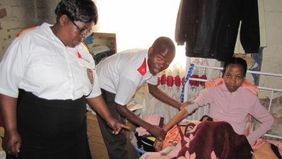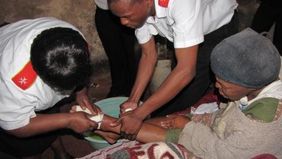Together with a nurse and a nursing assistant, I sit on a bench in the back of the ambulance. In the front is the nurse who leads the team and the driver, who is also a trained paramedic. First we go to the township of Sundumbili. In an examination centre, the nurse gives sputum samples for tuberculosis examination of patients. After a few hundred metres we stop again. We stand in front of a poor house. The nursing staff knocks. We notice that the door is not locked. We enter politely, feeling our way in. We go through a small kitchen into a bedroom. The sparse plaster is peeling off the red bricks. A young woman is sitting in bed, obviously in great pain. The nursing assistant measures the blood pressure and fever of the severely emaciated woman. The nurse checks that she is taking her medication. The young woman has AIDS. She had been an inpatient in the hospice before, but could be discharged. At home, the patient's condition has deteriorated so much that the nurse decides to bring her back to the hospice straight away.
The training to become a full nurse in South Africa takes six years. The competence of this professionally highly qualified force is great. Among other things, she is authorised to examine patients, prescribe medication or admit them to hospitals.
We take the woman's medication with us. All she has at home in terms of cosmetics is a toothbrush. Supported by the helpers, she walks with small steps to the ambulance. We take her to Blessed Gérard's Hospice. There she is thoroughly examined by the doctor and admitted as an in-patient.
The journey continues to Mangete. This time the road leads over gravel roads and further over very bumpy dirt roads. Small forests and wide sugar cane fields line the way. The scattered Zulu settlements are picturesquely scattered in the softly sloping hills in the distance. And again and again, palm trees dominate the overall picture. Meanwhile, the ambulance forces its way through very rough terrain. I hold on to the seat with both hands. We take countless turns until we reach our destination.
I was worried about my back because my bed was too soft, until I met a woman lying on the floor because she didn't have a bed.
The team gets out and we stand in front of a hut built of rubble stones. It measures about 2x3 metres inside. Behind the open door lies an emaciated woman on the floor wrapped in blankets. I am deeply shocked. The woman is coughing badly. She also has AIDS. Her entire possessions consist of a few heavily soiled clothes, a shard of mirror, two plastic plates, two cups, some aluminium cutlery and a small wall clock lying on the floor with a surprisingly moving second hand. In one corner of the room are a few stones, the fireplace. In a rusty tin can is her cooked maize porridge. The pot she had was stolen from her. The helpers spread a blanket in front of the hut and help the sick woman outside. The fresh air and the sun are obviously good for her. We completely clear out the hut and lay everything out in the sun. One of the nurses phones the care centre. A helper sprays some water from a canister on the dusty mud floor. The nurse starts to sweep up the dust and other dirt with the brush of a scrubber. I relieve her. At first she hesitates. I explain to her that I have three children of my own, no servants or household staff and that I am used to work, so she lets me. We dust out all the blankets and clothes, fold everything up and put everything back in the hut. The helpers make her bed as comfortable as possible and help the woman back into the hut. Her bony face smiles. Now the helpers take her blood pressure and fever and talk a lot to the weak woman. The nurse explains to me that this woman had already been in the hospice and wanted to go home at her own request because she has an eight-year-old son who would otherwise be all alone at home. Now he is at school. When we are done, I go to the woman again and wish her all the best and that I wish her a miracle. I stroke her skinny arm. She does not understand my words, but her eyes tell me that she has understood me. She gives me a smile.
Physiotherapy in Sundumbili
An AIDS patient, who had suffered a stroke and has hemiplegia, is now being taken by ambulance to Sundumbili for physiotherapy so that his muscles can be rebuilt and strengthened. I sit next to him and support him, as he is not able to hold on himself. A nurse is with him, who is instructed by the therapist to do these exercises with this patient every day. He is given an exercise plan with illustrated instructions to help him remember. The man, who receives a walking aid from the physiotherapist, later sits in the car with a relaxed expression on his face as he returns to the hospice. He feels that he is being helped. His health is important to others. He really thaws out and talks to the nurse and the carer. There is a relaxed, pleasant atmosphere. Of course, apart from polite phrases and a few prayers, I don't understand Zulu. And most Zulu people don't speak English. It is not possible for me to take part in the conversation.
A touching bond of love becomes visible to me
We load a box into the car. A staff member gets into the ambulance with writing materials in her hand. I let myself be surprised again where we are going. We had already driven this way today. I am very happy when we are again in front of the hut of the woman who has no bed. Her eight-year-old son is standing in the doorway of the hut. He is wearing the blue torn trousers that I had dusted and folded in the morning. All the helpers come into the little dwelling. Now I see what is in the box: maize flour, rice, sugar, oil, beans and some other essential food. Such direct aid is financed by Blessed Gérard's Emergency Relief Fund. The woman who came along is the social worker of the Care Centre. She talks to the boy in detail. He is obviously taking care of his sick mother on his own. He tells us that he is afraid that their food could be stolen, after the cooking pot was taken away from them. The sick woman makes eye contact with me while the others talk to the boy. Her eyes wander to her son and then she looks at me again. I nod at her and I understand that he is all she has. I am moved by how much she is attached to him and probably also dependent on him. This moment will probably never let me go again. It is deeply engraved in my heart. Meanwhile, some of the food is packed into the only plastic bag they have and covered with clothes. Some of the sugar finds a place in a small box. Now everyone leaves the hut. I say goodbye again and try to promise the woman with my gaze that there is hope for her. She smiles again. It is hard for me to say goodbye. The boy gets into the ambulance with us. The nurse explains to me that we will go to acquaintances of the sick. The boy says that the food is safe there. We meet the family, explain the situation and leave the supplies at their house. The sister takes down the phone number of the acquaintances and after a short negotiation, the woman and her almost grown-up daughter come with all of us to the hut of the sick. Afterwards we drive on. Later I learn that the acquaintances have agreed to visit the patient every day. She urgently needs in-patient treatment in the hospice, but is not willing to do so at the moment because she does not want to and cannot leave her son alone. The social worker at the care centre is now looking for ways to help the boy when his mother is admitted to the hospice. It is never too late for treatment with antiretroviral drugs, but without the treatment she will be dead within a short time. If she were to take the medicine regularly, she could prolong her life considerably, so that she could then look after her son herself again, work again and then also live in a more dignified dwelling.
Antiretroviral drugs prevent the HI viruses from multiplying in the blood. This means that the patient soon feels completely well and can continue to live in good health for another 15, 20 or even 25 years. The medication must be taken regularly and without interruption to ensure the success of the treatment.
Now the path leads back to the main road and soon we turn off again on the opposite side and are on bush tracks for a while until we meet the next patient. A man who had had many wounds on his back is being re-examined. His condition has improved a lot in the meantime and only crusts remain. The nurse writes her treatment report in the medical record that is kept for each patient. The man has a reason to laugh again. That is the main thing.
On the way, the nurse gets a call. We turn around and drive back a bit of the way. We turn onto a dirt road. A man stands opposite us in a pickup truck and makes clear gestures where we should go. Obviously they need our help. After a relatively short drive over what have become the usual bumpy dirt roads, we arrive at a house. The man with the pickup is already there and leads us into the house. His mother is lying in bed and the nurse is folding back the blanket. The woman has a second-degree burn on the instep of her left foot. The nurse cleans the extensive wound first with a disinfectant solution and then with a wound healing ointment and sterile compresses and applies a bandage. Blood pressure and temperature are also routinely taken. The nurse also performs a blood sugar test. She recommends that she be taken to the local clinic to be given an antibiotic. The team gives recommendations to the relatives.
On the way back, I look out of the narrow field of vision of the ambulance into the hilly landscape with the setting sun playing with the blades of grass. I am full of admiration for this team that provides this service to the poor day in and day out. They helped tirelessly, competently and humanely. Above all, their humanity has left a lasting impression on me.
Mechthilde Lagleder






